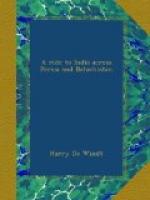The caravanserai at Meyun Kotal is one of the finest in Persia. It was built by Shah Abbas, and is entirely of stone and marble. Surrounded by walls of enormous thickness, the building is in the shape of a square. Around the latter are seventy or eighty deep arches for the use of travellers. At the back of each is a little doorway, about three feet by three, leading into a dark, windowless stone chamber, unfurnished, smoke-blackened, and dirty, but dry and weather-proof. Any one may occupy these. Should the beggar arrive first, the prince is left out in the cold, and vice versa. Everybody, however, is satisfied as a rule, for there is nearly as much accommodation for guests as in a large London or Paris hotel. Behind the sleeping-rooms is stabling for five or six hundred horses, and, in the centre of the courtyard, a huge marble tank of pure running water for drinking and washing purposes. This, and fodder for the horses, is all that there was to be got in the way of refreshment. But Gerome, with considerable forethought, had purchased bread, a fowl, and some eggs on the road, and, our room swept out and candles lit, we were soon sitting down to a comfortable meal, with a hissing samovar, the property of the caravanserai-keeper, between us.
One need sleep soundly to sleep well in a caravanserai. At sunset the mules, with loud clashing of bells, are driven into the yard from pasture, and tethered till one or two in the morning, when a start is made, and sleep is out of the question. In the interim, singing, talking, story-telling, occasionally quarrelling and fighting, go on all round the yard till nearly midnight. Tired out with the stiff climb, I fell into a delicious slumber, notwithstanding the noise, about nine o’clock, to be awakened shortly after by a soft, cold substance falling heavily, with a splash, upon my face. Striking a match, I discovered a large bat which the smoke from our fire (there was no chimney) had evidently detached from the rafters.
I purchased, the next morning before starting, a Persian dagger belonging to one of the caravan-men. He was one of the Bakhtiari, a wild and lawless tribe inhabiting a tract of country (as yet unexplored by Europeans) on the borders of Persia and Asia Minor. The blade of the dagger is purest Damascene work, the handle of fossilized ivory. On the back of the blade is engraved, in letters of inlaid gold, in Arabic characters—
“There is one God! He is Eternal!”
“Victory is nigh, O true believer!”
Connoisseurs say that the dagger is over a hundred years old. After quite an hour’s haggling (during which our departure was delayed, much to Gerome’s disgust), I managed to secure it for L9 English money, although the Bakhtiari assured me that he had already sworn “by his two wives” never to part with it. I have since been offered four times the amount by a good judge of Eastern weapons.
A second pass, the Kotal Doktar, lay between us and Bushire. Though steep and slippery in places, the path is well protected, and there are no boulders to bar the way. On leaving the caravanserai, we paused to examine the second longest telegraph wire (without support) in the world. It is laid from summit to summit of two hills, and spans a valley over a mile in width. [C]




